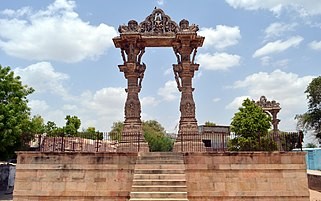Description

Disclaimer: Copyright infringement not intended.
Context
- Vadnagar city in Gujarat is the hometown of Prime Minister Narendra Modi.
- A school, which PM attended, will be redeveloped by Ministry of Culture.
- As part of a joint initiative by the central and state governments, children from across the country will stay and learn to live a very evolved life at Prerna school.
Vadnagar city
- Vadnagar city is L-shaped town in northern part of Gujarat spreading across 85 hectares.
- During different periods of its history this city has been known by names like Anartapura, Anandapur, Chamatkarpur.
- It was included in Tentative list of the UNESCO World heritage sites in December 2022.

Excavations and findings
- Archaeological excavations in the city were undertaken first by archaeologists B Subbarao and RN Mehta from Maharaja Sayajirao University of Baroda in 1953.
- Recently, from 2014, the excavation work, in Vadnagar’s Ghaskol, Darbargadh and Badi Garbano Sheri, taken over by the ASI has found over 20,000 artefacts.
- Aim of such excavation of ASI is to establish its chronology and to help create an Experiential Museum.
- This city is found to be a multi-layered and multi-cultural mercantile settlement.
History of the city
- Abul Fazl’s Ain-e-Akbari terms this city as a large and ancient city inhabited by Brahmans and which contains 3,000 pagodas with tanks.
- Seven successive cultures, without a break, going back to 750 BCE was found which are given below –
- Pre-rampart phase (in 2nd century BCE).
- Rampart phase (2nd century BCE – 1st century CE).
- Kshatrapa phase (1st – 4th century CE).
- Post-Kshatrapa phase (5th – 9th/10th century CE).
- Solanki phase (10th – 13th century CE).
- Sultanate-Mughal phase (14th – 17th century CE) and
- Gaekwad phase (17th/18th – 19th century CE).
Trade
- Conch shell, with 11,000 shell bangles, cowry shells and other wares found here hinting a flourishing trade industry.
- It implies, particularly cowry shells, its indirect involvement in overseas trade to the Maldives.
- The city was one of the important hinterland land ports (Sthal Pattan) of Gujarat. It was Located at the intersection of two major trade routes –
- Central India to Sindh and northwest and
- Gujarat to Rajasthan and north India.
- A gold coin, believed to be of the Mamluk dynasty of Egypt (15th century), has also been found strengthening the belief in overseas trade.
Buddhism and Jainism Influence
- Excavation works also finds fortification, a Buddhist monastery, votive stupas, house-complexes, lanes/streets which mainly belonged to pre-2nd century BCE to the Gaekwad period.
- In 1992, a red sandstone image of a Bodhisattva or a deity-like revered figure in Buddhism was recovered from Vadnagar.
- It was an important centre of Sammitya Buddhists, a sect of Buddhism which was supported by Chinese traveller Hieun Tsang.
- As per Hieun Tsang or Xuanzang, who visited Vadnagar around 641 CE and called it o-nan-to-pu-lo (Anandpur), in 10 monasteries there were 1000 monks of the Sammitiya School (Little Vehicle).
- This city also shows Jain influence as according to a stone inscription of Arjuna Bari, the Jain King Kumarpal from the Solanki dynasty undertook repairs of the fort wall in 12th century CE.
Architecture and monuments
- It was a historic fortified settlement, and religious centre/temple town.
- Gates like the Ghanskol and Pithori are of the 11th- 12th century CE.
- Other prominent gates are Nadiol Gate, Amtol Gate, Amarthol Gate and Arjun Bari Gate (protected by the ASI).
- The Ambaji Mata Temple dates back to 10th-11th century CE, while other important Hindu and Jain temples within the town are from the 17th century onwards. For instance Hatkeshwar temple.
Roman influence
- The ASI claims a “Roman connection” owing to the discovery of
- An intaglio in clay of Greco-Indian king Apollodotus II and a sealing of of a Roman coin belonging to Valentinian-I.
- A clay intaglio is a coin mould of Greco-Indian king Apollodotus II (80-65 BC)
- Indigenous pottery, for instance as torpedo jars and Glazed, establishes the city’s connections with Sassanid region and West Asia.
Must read article:
UNESCO World Heritage sites
https://www.iasgyan.in/daily-current-affairs/world-heritage-sites-47
https://www.iasgyan.in/daily-current-affairs/unesco-world-heritage-sites
Archaeological Survey of India (ASI)
https://www.iasgyan.in/daily-current-affairs/agra-fort-1
https://www.iasgyan.in/daily-current-affairs/centre-reconstitutes-panel-for-studying-sarasvati-river

Significance of the excavations in city
- It plays a major role in the hinterland trade network of Western India.
- Unlike the sites like Harappa and Kalibangan, It proves city’s resilience and outstanding universal value as the city survives from centuries.
- It shows more than 2700 years of constant occupation.
- The city is a living city which is continuously evolving and shows the prominence of extensive water management system.
|
PRACTICE QUESTION
By highlighting the historical significance of Vadnagar city, explain the criteria required for a place to be listed as a UNESCO world heritage site. (150 words)
|
https://indianexpress.com/article/explained/explained-culture/pm-modi-school-hometown-vadnagar-history-8652733/







